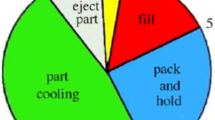Abstract
In the prediction of gas flow-direction for gas-assisted injection molding (GAIM), the statement“Gas goes to the direction of the last area to fill with resin”, has been accepted as a correct one. When there exists more than one area to fill with resin, a mold design engineer for GAIM technologies has to determine to which direction gas goes that commercial software for GAIM (e.g., Moldflow) may be utilized for its mold design. However commercial software is generally expensive and is sometimes hard to become familiar with. As a rule of thumb, it is suggested that the resistance to the initial velocity of melt polymer at the nearest geometry to a gas injection point should be used as its criterion since gas goes in the direction of least resistance to initial resin-velocity. Neither the flow rate nor the resistance to flow rate can be a criterion in the prediction. Thus the statement“Gas goes to the direction of the least resistance to flow rates”, should be corrected to“More flow rate goes to the direction of the least resistance to flow rates.”, The rule of thumb suggested in this paper was verified by using commercial software, Moldflow, in the prediction of gas flow directions in GAIM under geometries where cavities and runners were involved. When the ratio of initial resin-velocity is so close to unity it is proposed as the adapted rule of thumb to calculate new emerging resin-velocities and resistances to resin-velocity at the first coming change of diameters in series of pipes and to compare those for upper and lower sides each other to predict the gas direction. Thus the judgment as to which point is the point where gas starts to choose a preferred direction is very important in the prediction.
Similar content being viewed by others
References
Chen, S.-C., Cheng, N. T. and Hsu, K. S., “Simulations and Verification of the Secondary Gas Penetration in a Gas Assisted Injection Molded Spiral Tube”,International Communications in Heat and Mass Transfer,22, 319 (1995).
Chen, S.-C., Cheng, N. T. and Hsu, K. S., “Simulations of Gas Penetration in Thin Plates Designed with a Semicircular Gas Channel During Gas Assisted Injection Molding”,Int. J. Mech Sci.,38, 335 (1996a).
Chen, S.-C., Cheng, N.-T, Hsu, K. F. and Hsu, K.-S., “Polymer Melt Flow and Gas Penetration in Gas Assisted Molding of a Thin Part with Gas Channel Design”,Int. J. Heat Mass Transfer,39, 2957 (1996b).
Chen, S.-C., Cheng, N.-T. and Chao, S.-M., “Simulations and Verification of Melt Flow and Secondary Gas Penetration During a Gas Assisted Injection Molding”,International Polymer Processing,14, 90 (1998).
Gao, D. M., Nguyen, K. T., Garcia-Rejon and Salloum, G., “Optimization of the Gas Assisted Injection Moulding Process Using Multiple Gas-injection Systems”,Journal of Materials Processing Technology,69, 282 (1997).
Khayat, R. E., Derdouri, A. and Herbert, L. P., “A Three-dimensional Boundary-element Approach to Gas Assisted Injection Molding”,J. Non-Newtonian Fluid Mech.,57, 253 (1995).
Lim, K. H. and Soh, Y. S., “The Diagnosis of Flow Direction Under Fan Shaped Geometry in Gas Assisted Injection Molding”,Journal of Injection Molding Technology,3, 31 (1999).
McCabe, W. L., Smith, J. C. and Harriot, P., “Unit Operations of Chemical Engineering”, 4th Ed., McGraw-Hill Press (1986).
Parez, M. A., Ong, N. S., Lam, Y. C. and Tor, S. B., “Gas-assisted Injection Molding: The Effects of Process Variables and Gas Channel Geometry”,Journal of Material Processing Technology,121, 27 (2002).
Shen, Y. K., “Study on the Gas-liquid Interface and Polymer Melt Front in Gas Assisted Injection Molding”,Int. Comm. Heat Mass Transfer,24, 295 (1997).
Shen, Y. K., “Study on Polymer Melt Front, Gas Front and Solid Layer in Filling Stage of Gas Assisted Injection Molding”,Int. Comm. Heat Mass Transfer,28, 139 (2001).
Soh, Y. S. and Lim, K. H., “Control of Gas Direction in Gas Assisted Injection Molding; Definition of Resistance to Velocity, rV”,SPE ANTEC Tec. Papers,60, 482 (2002).
Soh, Y. S., “Control of Gas Direction in Gas Assisted Injection Molding”,Journal of Reinforced Plastics and Composites,19, 955 (2000).
Author information
Authors and Affiliations
Corresponding author
Rights and permissions
About this article
Cite this article
Lim, KH., Lee, E.J. Prediction of gas flow directions in gas assisted injection molding when cavities and runners are involved. Korean J. Chem. Eng. 20, 592–599 (2003). https://doi.org/10.1007/BF02705571
Received:
Accepted:
Issue Date:
DOI: https://doi.org/10.1007/BF02705571




